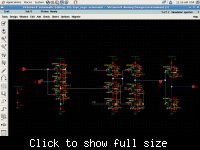mohamedabouzied
Member level 3
sizing tspc d flip flop
Dear all,
i don't know how to choose the device sizing for True single phase clock TSPC logic?
Especially, an edge triggered D flip flop DFF.
I put the transistors in its minimum sizing, but the DFF doesn't work, so i feel that i must size the transistors well in order to make the DFF functions well.
ANy suggestions?
Thanx in advance
Mohamed Abouzied
Dear all,
i don't know how to choose the device sizing for True single phase clock TSPC logic?
Especially, an edge triggered D flip flop DFF.
I put the transistors in its minimum sizing, but the DFF doesn't work, so i feel that i must size the transistors well in order to make the DFF functions well.
ANy suggestions?
Thanx in advance
Mohamed Abouzied
